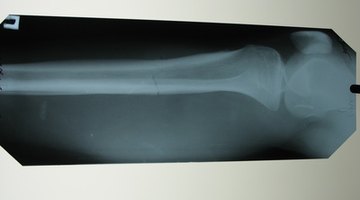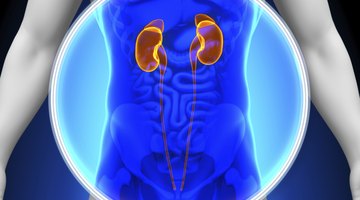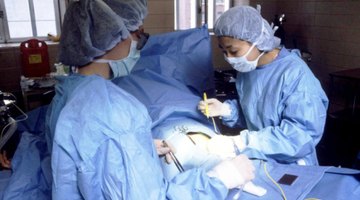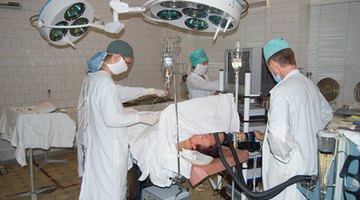Complications of Aspiration During Surgery
During surgical anesthesia, respiratory reflexes such as gag reflexes that normally prevent vomited food or gastric juices from entering the lungs are suppressed. Food, stomach juices, blood or saliva can enter the trachea, the tube that leads to the lungs. Aspiration of the substance into the lungs can cause respiratory problems. Aspiration often occurs in people undergoing emergency surgery who have recently eaten, people who are obese or pregnant, or those under deep anesthesia, Gisele de Azevedo Prazeres, M.D. reports on MedStudents. Life-threatening complications can occur after aspiration during surgery.
Penumonitis
Pneumonitis is inflammation from aspiration of toxic substances, most commonly gastric juices during surgery. Aspiration of gastric acid burns and irritates the airway and lungs, causing swelling, constriction of the bronchial tubes, collapse of part of the lung and bleeding from the small airways called alveoli. Rapid breathing and pulse, wheezing, cough and fever may occur. Patients may require supplemental oxygen therapy or mechanical ventilation with a respirator. If signs of penumonitis appear within two hours of surgery, 75 percent will require one of these two treatments, Dr. Prazeres states.
Lung Infection

Abdominal Surgery Postoperative Complications
Learn More
Pneumonia, infection in the lung, can also result from aspiration during surgery. Lung abscess, an infection in the lung characterized by a collection of pus in the lung, may also occur. Aspiration pneumonia causes cough, chest pain, fever, fatigue, shortness of breath and wheezing.cause:
- Aspiration pneumonia causes cough
- chest pain
- fever
- fatigue
- shortness of breath
- wheezing
Skin may have a bluish tinge from lack of oxygen known as cyanosis. Foul smelling sputum may also appear. Symptoms of lung abscess are similar to those of pneumonia. Antibiotic treatment given either orally or intravenously helps clear the infection, although lung abscesses may require surgical drainage.
Adult Respiratory Distress Syndrome
Adult respiratory distress syndrome, or ARDS, is fatal in 25 to 40 percent of people, says MayoClinic.com. ARDS causes air sacs in the lungs to fill with fluid. Symptoms include:
- severe shortness of breath with rapid
- labored breathing
- cough
- fever
- confusion
- low blood pressure
- extreme fatigue
Supplemental oxygen or mechanical ventilation help supply adequate oxygenation to the body. ARDS can cause pulmonary fibrosis, scarring of the tissue between the air sacs, which makes lungs stiff. Lung collapse, called pneumothorax, can occur from mechanical ventilation. ARDS can leave a person with permanent lung and cognitive damage.











